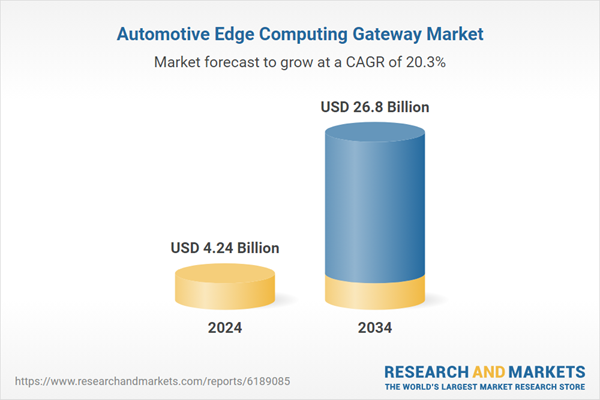The surge in market growth is driven by the increasing integration of smart in-vehicle electronics, connected and autonomous vehicles, and the need for real-time data processing. Stricter safety and cybersecurity regulations, rapid adoption of Advanced Driver Assistance Systems (ADAS), and the shift toward electric and software-defined vehicles are key factors accelerating demand. Automotive edge gateways serve as crucial computing nodes within vehicles, facilitating seamless data exchange between sensors, Electronic Control Units (ECUs), and cloud platforms, while ensuring low latency, high reliability, and secure communication. The pandemic exposed vulnerabilities in semiconductor supply chains, prompting investments in localized chip manufacturing, edge computing certifications, and resilient backup systems. Additionally, the expansion of connected mobility, electric vehicles, and intelligent fleet management has driven investments in edge computing units enabling Vehicle-to-Everything (V2X) communication and AI-powered predictive analytics.
The hardware segment held a 54% share and is forecasted to grow at a CAGR of 20.4% through 2034. Vehicles increasingly depend on high-performance computing components to manage real-time data, support ADAS, and enable autonomous functionalities. Microcontrollers, system-on-chip (SoC) modules, radar and lidar interface ICs, GPUs, and AI accelerators provide the computational power needed to process vast sensor data instantly.
The large enterprises segment held a 72% share and is projected to grow at a CAGR of 19.9% during 2025-2034. Large organizations lead due to extensive financial resources, advanced R&D capabilities, and the ability to integrate high-performance computing systems across extensive vehicle fleets. Economies of scale also enable these companies to deploy secure, scalable, and high-speed edge computing solutions on a global scale.
U.S. Automotive Edge Computing Gateway Market held 85% share and generated USD 1.09 billion in 2024. Growth is fueled by the rise of connected and autonomous vehicles, which produce significant data streams from sensors, cameras, and telematics systems. Edge computing enables real-time processing, critical for enhancing safety, optimizing bandwidth, and improving user experience. Automakers and technology providers are increasingly deploying edge gateways to address latency challenges and enable faster decision-making.
Key players in the Global Automotive Edge Computing Gateway Market include NXP, Infineon, STMicroelectronics, Huawei, Continental, Bosch, NVIDIA, Qualcomm, Denso, and Renesas Electronics. Companies in the Automotive Edge Computing Gateway Market are leveraging innovation, strategic partnerships, and product diversification to strengthen their market presence. They are investing heavily in AI-enabled edge platforms and high-performance hardware to enhance processing capabilities for connected and autonomous vehicles. Collaborations with automakers and technology providers are accelerating the deployment of scalable and secure edge solutions. Firms are also focusing on R&D for energy-efficient computing modules, optimizing latency and bandwidth usage.
Comprehensive Market Analysis and Forecast
- Industry trends, key growth drivers, challenges, future opportunities, and regulatory landscape
- Competitive landscape with Porter’s Five Forces and PESTEL analysis
- Market size, segmentation, and regional forecasts
- In-depth company profiles, business strategies, financial insights, and SWOT analysis
This product will be delivered within 2-4 business days.
Table of Contents
Companies Mentioned
The companies profiled in this Automotive Edge Computing Gateway market report include:- Amazon
- AMD
- Cisco
- Huawei
- Infineon
- NVIDIA
- NXP Semiconductors
- Qualcomm Technologies
- Renesas Electronics
- STMicroelectronics
- Aptiv
- Autotalks
- Bosch
- Continental
- Denso Corporation
- Mobileye
- Siemens
- Valeo
- ZF Friedrichshafen
- BlackBerry Limited (QNX)
- Hewlett Packard Enterprise (HPE)
Table Information
| Report Attribute | Details |
|---|---|
| No. of Pages | 209 |
| Published | October 2025 |
| Forecast Period | 2024 - 2034 |
| Estimated Market Value ( USD | $ 4.24 Billion |
| Forecasted Market Value ( USD | $ 26.8 Billion |
| Compound Annual Growth Rate | 20.3% |
| Regions Covered | Global |
| No. of Companies Mentioned | 22 |









